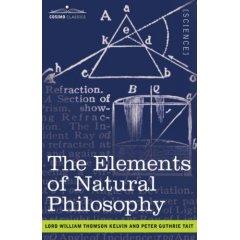| 2020ok Directory of FREE Online Books and FREE eBooks |
Free eBooks > Nonfiction > Philosophy > General > Elements of natural philosophy
Elements of natural philosophyby Tait  Download Book (Respecting the intellectual property of others is utmost important to us, we make every effort to make sure we only link to legitimate sites, such as those sites owned by authors and publishers. If you have any questions about these links, please contact us.) link 1 link 2 About Book Book Description Originally published in 1873, Elements of Natural Philosophy is a condensed version of Lord Kelvin and Peter Tait's revolutionary work Treatise on Natural Philosophy. This version is designed for beginning students and the examples and lessons it contains use only geometry, algebra, and trigonometry, eschewing the calculus of the more advanced edition. Written for math students at the university level, this textbook will be of interest to anyone with a love for math and science. Irish scientist, engineer, and author LORD WILLIAM THOMSON KELVIN (1824-1907) is considered an foundational thinker of modern physics. He invented the Kelvin temperature scale and also helped develop the first transatlantic telegraph cable. Scottish physicist PETER GUTHRIE TAIT (1831-1901) is most famous for writing, with Lord Kelvin, the groundbreaking physics textbook Treatise on Natural Philosophy (1867). About the Author William Thomson, who became Lord Kelvin of Largs (Scotland) in 1892, was born on June 26, 1824, in Belfast, Ireland. His father, James Thomson, was a textbook writer and mathematics teacher who moved his family to Glasgow, Scotland, in 1832. Thomson entered the university there at the age of ten. A brilliant student, by the time he was twenty-one he had studied at the University of Glasgow, taken his B.A. degree at the University of Cambridge, worked in the Paris laboratory of physicist and chemist Henri-Victor Regnault, and had published twelve scientific papers. In 1846 he was appointed professor of natural philosophy at the University of Glasgow, a position he held until 1899. There he established the first physics laboratory in Great Britain. His investigations into the properties of matter made him famous. Thomason supervised the laying of the first transatlantic cable in 1866. He also invented and patented the mirror galvanometer (telegraph receiver) and the siphon recorder to improve cable communication. For this work he was knighted by Queen Victoria in 1866. Thomson traveled widely in Europe and the United States, and gave a series of lectures at Johns Hopkins University in 1884 on the state of scientific knowledge. His interst in yachting and the sea inspired him to invent, patent, and manufacture a compass used by the British Admiralty, a calculating machine that measured tides, and sounding (or depth-measuring) equipment. With Peter Guthrie Tait, he wrote the textbook TREATISE ON NATURAL PHILOSOPHY, which was published in 1867 and was a major influence on future physicists. THE ELEMENTS OF NATURAL PHILOSOPHY (1872), coauthored with Tait, consisted, in great part, of the nonmathematical portion of the TREATISE ON NATURAL PHILOSOPHY. Before his death at Netherhall, near Largs, on December 17, 1907, Thomason had become an honorary member of many foreign academies and held honorary degrees from many universities world-wide. He served as president of the Royal Society from 1890 to 1895. At the time of his death Thomson had published more than six hundred papers and had been granted dozens of patents. He is buried at Westminster Abbey, London. Physicist and mathematician Peter Guthrie Tait was born on April 28, 1831, in Dalkeith, Midlothian, southeastern Scotland. After serving from 1852 to 1854 as a fellow and lecturer of Peterhouse College, Cambridge, Tait took a professorship in mathematics at Queen's College, Belfast. There he joined the noted Irish chemist Thomas Andrews (1813-1885) in research on the density of ozone and the effect of electric discharges on oxygen and other gases. From 1860 he was professor of natural philosophy at the University of Edinburgh. Tait made fundamental contributions to the theory of quaternions (an advanced algebra that gave rise to vector analysis and was instrumental in the development of modern mathematical physics). His ELEMENTARY TREATISE ON QUATERNIONS (1867) went through three editions. Later he wrote INTRODUCTION TO QUATERNIONS (1873). In collaboration with the English physicist William Thomson, Lord Kelvin, Tait produced TREATISE ON NATURAL PHILOSOPHY (1867), followed by THE ELEMENTS OF NATURAL PHILOSOPHY. After publication of TREATISE ON NATURAL PHILOSOPHY, Tait concentrated on studies of thermoelectricity and thermal conductivity. With the Scottish physicist Balfour Stewart he wrote THE UNSEEN UNIVERSE (1867), followed by the sequel, PARADOXICAL PHILOSOPHY (1878). Tait died in Edinburgh, Scotland, on July 4, 1901. Related Free eBooks
| Related Tags |












SEND A COMMENT
PLEASE READ: All comments must be approved before appearing in the thread; time and space constraints prevent all comments from appearing. We will only approve comments that are directly related to the article, use appropriate language and are not attacking the comments of others.